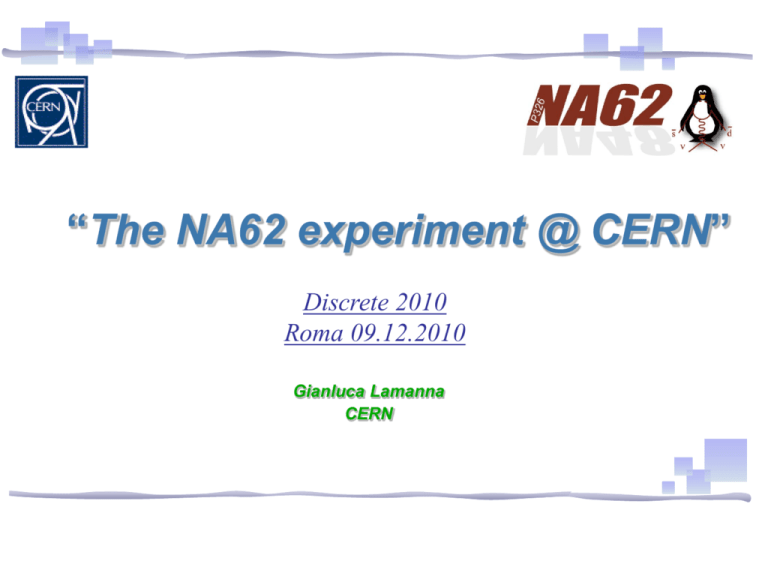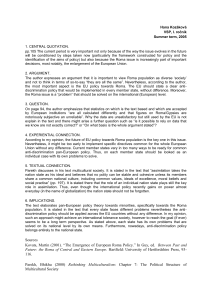G.Lamanna – Discrete 2010 – Roma
advertisement

“The NA62 experiment @ CERN” Discrete 2010 Roma 09.12.2010 Gianluca Lamanna CERN G.Lamanna – Discrete 2010 – Roma Outline The K→pnn in the SM and beyond NA62 experimental technique NA62 experiment: ..at the heart of LHC NA48 NA62 Signal & background Detectors Trigger Sensitivity Conclusions NA62 Collaboration Bern ITP, Birmingham, Bristol, CERN, Dubna, Ferrara, Fairfax, Florence, Frascati, Glasgow, IHEP, INR, Liverpool, Louvain, Mainz, Merced, Naples, Perugia, Pisa, Rome I, Rome II, San Luis Potosi, SLAC, Sofia, TRIUMF, Turin 2 FCNC process forbidden at tree level Short distance contribution dominated by Z penguins and box diagrams Negligible contribution from u quark, small contribution from c quark Very small BR due to the CKM top coupling → l5 Amplitude well predicted in SM (measurement of Vtd) [see E.Stamou] Residual error in the BR due to parametric uncertainties (mainly due to charm contributions): ~7% Alternative way to measure the Unitarity Triangle with smaller theoretical uncertainty r GSD/G Irr. theory err. BR x 10- KL→pnn >99% 1% 3 K+→p+nn 88% 3% 8 KL→p0e+e- 38% 15% 3.5 KL→p0m+m- 28% 30% 1.5 a g K0→π0νν G.Lamanna – Discrete 2010 – Roma K+→p+nn in the Standard Model b KL→m+m- charm h 11 3 G.Lamanna – Discrete 2010 – Roma K+→p+nn beyond the SM Stringent test of the SM Several SM extensions predict different value for the BR Possibility not only to identify new physics but also to distinguish among different models: SUSY, MSSM (with or without new sources of CPV or FV), 5-dim split fermions, topcolor, multi Higgs, light sgoldstino, extra-dimensions, ... Example: in MSSM the departure from the SM should reach 10%-20% for reasonable parameters values Higher effects with respect to the B decays 4 G.Lamanna – Discrete 2010 – Roma Experimental technique Kaon decay in-flight from an unseparated 75 GeV/c hadron beam, produced with 400 GeV/c protons from SPS on a fixed berilium target ~800 MHz hadron beam with ~6% kaons The pion decay products in the beam remain in the beam pipe Goal: measurement of O(100) events in two years of data taking with % level of systematics Present result (E787+E949): 7 events, total error of ~65%. 5 G.Lamanna – Discrete 2010 – Roma Experimental technique Advantages w.r.t. decay at rest (i.e. E949@BNL): Easy to veto higher energy photons Decay Easy to have high intensity beam m+n (Km2) Disadvantages: p+p0 (Kp2) Long detector and decay region p+p+pEvent by event measurement of the kaon momentum p0e+n (Ke3) Unseparable hadron beam p0m+n (Km3) Very challenging experiment: Weak signal signature: BRSM=8x10-11 Potentially huge background from kaon decays Key points: 1. Kinematic rejection 2. Vetos 3. Particle identification 4. Trigger p+p0p0 m+ng BR 63.5% 20.7% 5.6% 5.1% 3.3% 1.8% (Km2g) 0.62% p+p0g 2.7×10-4 p+p-e+n (Ke4) 4.1×10-5 p0p0e+n (Ke400) 2.2×10-5 e+n 1.5×10-5 (Ke2) p+p-m+n (Km4) 1.4×10-5 6 G.Lamanna – Discrete 2010 – Roma 1) Kinematic rejection Pp PK pK 92% Kinematically constrained Pn Pn P P 2 mmiss mK2 1 - p + mp2 1 - K - PK Pp p2K PK Pp The missing mass will be used to identify two regions with lower background level Very important to have high resolution missing mass reconstruction Measurement of kaon and pion momenta Very light spectrometers to keep the multiple scattering as low as possible. 7 G.Lamanna – Discrete 2010 – Roma 1) Kinematic rejection: Gigatracker GTK1 9.6 m 60 mm 13.2 m GTK3 GTK2 Momentum reconstruction on high intensity beam → three stations in an achromath dipole system Thin detector → 200 mm pixel sensor+100 mm readout chip (<0.5% X/X0 per station) 18000 pixels, 150 kHz rate per single pixel in the central part Excellent time resolution to match the measurement with the other detectors → <200 ps achieved in test beam Cooling system to control the leakage current given by the radiation damage → microchannel cooling or standard cooling in light material vessel. s(PK)/PK~ 0.2% s(dX/dZ)/(dX/dZ)~16 mrad 8 G.Lamanna – Discrete 2010 – Roma 1) Kinematical rejection: Straws tracker Spectrometer in vacuum to decrease MS effects 4 chambers with 4 redundant views each (4 staggered layer per view) Magnet with Ptkick = 256 MeV/c 2.1 m long straws, 9.6 mm mylar tubes <0.1% X/X0 per view Central “hole” (6 cm radius) for the beam obtained removing straw tubes in the central region Full length prototype built and tested in vacuum at SPS@CERN in 2007 and 2010 s(Pp)/Pp~ 0.3% 0.007%*Pp (GeV/c) s(dX/dZ)/(dX/dZ)~ 45-15 mrad Rejection power: 104 (K→pp0), 105 (K→mn) 9 G.Lamanna – Discrete 2010 – Roma Not kinematically constrained background ~8% of the Kaon decays is not kinematically constrained. Rejection is based solely on veto and particle identification. The veto and PID are exploited to reach the 108 rejection factor in the kinematical constrained background 8% Not Kinematically constrained Veto system requirements: Large angle (8.5-50 mrad): inefficiency <10-4 for g between 100 MeV and 35 GeV Forward veto (1-8.5 mrad): inefficiency <10-5 for E>10 GeV Small angle (<1 mrad): <10-3 for E>10 GeV PID system requirements: Positive kaon identification in the hadron beam p-m separation: 10-3 mis-identification probability 10 G.Lamanna – Discrete 2010 – Roma 2) Vetos: LAV 12 rings along the decay region (in vacuum) Fully angular coverage in the 8.5-50 mrad range OPAL calorimeter lead glass reused: 5 staggered rings per station more than 2500 cristals in total Block tested at BTF@Frascati: inefficiency < 10-4 for 476 MeV e+ Time resolution: 700 ps Large dinamic range → double threshold readout with clamping diode and ToT technique 3 rings built and tested. 11 G.Lamanna – Discrete 2010 – Roma 2) Vetos: LKr LKr : old NA48 electromagnetic calorimeter, cryogenic liquid kripton Quasi homogeneous ionization chamber more than 13000 channels 27 X0 Excellent energy resolution very good time resolution: 100 ps New readout electronics: 14 bits 40 MHz ADC with large buffers g p g The performances as photon veto has been measured in a special run with 75 GeV kaon decays: Energy(GeV) Inefficiency 2.5-5.5 10-3 5.5-7.5 10-4 7.5-10 5x10-5 >10 8x10-6 12 G.Lamanna – Discrete 2010 – Roma 2) Vetos: CHANTI,SAC & IRC Small angle calorimeters: IRC & SAC IRC: to increase the acceptance for small angle g in the region not covered by the LKr SAC: to detect g in the beam pipe region The IRC is located around the beam pipe in front of the LKr, the SAC is located in the beam dump, at the very end of the experiment. The CHANTI is located after the GTK station three in order to detect interaction in the beam spectrometer IRC, SAC and CHANTI are in advanced R&D status 13 G.Lamanna – Discrete 2010 – Roma 3) PID: CEDAR Positive identification of the kaon in the hadron beam Purpose: tagging the kaon to decrease the requirements for the vacuum in the decay region (10-5 mbar). Technique: differential H2 cherenkov detector. Old detector built at CERN in the ’70 New readout (PMs and electronics) New deflecting mirrors system to decrease the rate per single channel on the readout. 14 G.Lamanna – Discrete 2010 – Roma 3) PID: RICH e 17 m long, 3 m in diameter Filled with 1 atm Neon p-m separation in the 15-35 GeV/c range Cherenkov light collected in two spots: 1000 PM each Full length prototype tested in 2009 Average time resolution: 70 ps Integrated mis-indentification probability: ~5x10-3 p = 15 GeV/c p m 15 G.Lamanna – Discrete 2010 – Roma 3) PID: MUV MUV 3 MUV 1-2 LKr MUV1-2 : to reach a factor of 106 in muon rejection (combined with the RICH) Partially reused the NA48 Hadron calorimeter Iron and scintillator MUV3: fast muon identification plane for trigger modules of 22x22 cm2 with 5 cm thick scintillator readout with 2 PMs <1ns time resolution achieved in test beam 16 10 MHz RICH MUV CEDAR STRAWS LKR 1 MHz 1 MHz 1 MHz L0TP PC PC PC PC PC L1 PC LAV L0 GigaEth SWITCH PC PC PC PC PC PC PC PC PC PC PC PC PC PC Trigger primitives Data PC PC PC PC CDR • L0: Hardware level. Decision based on primitives produced in the RO card of detectors partecipating to trigger • L1: Software level. “Single detector” PCs • L2: Software level. The informations coming from different detectors are merged together EB O(KHz) L0 trigger L2 G.Lamanna – Discrete 2010 – Roma 4) Trigger 17 G.Lamanna – Discrete 2010 – Roma 4) Trigger L0 selection: RICH+!LKR+!MUV3 RICH: hit multiplicity positive signal !LKR: no 2 clusters more than 30 cm apart !MUV3: no signal in MUV3 Very good time resolution is required to avoid random veto At the software levels a more complete analysis will be performed (missing mass, Z vertex,…) Initial rate (MHz) After L 0 (MHz) pp0 1.9 0.22 mn 5.7 0.04 ppp 0.5 0.1 ppp0 0.16 0.002 p0en 0.3 0.05 p0mn 0.2 0.002 TOT 6.7 0.4 pnn (eff.) 82% Input (max) Output (max) latency L0 hw,sync ~10 MHz ~ 1 MHz 1 ms L1 soft,async ~ 1 MHz ~ 100 kHz undefined L2 soft,async ~ 100 kHz O(kHz) undefined 18 G.Lamanna – Discrete 2010 – Roma 4) GPU trigger The idea: exploit GPUs (standard video card processors) to perform high quality analysis at trigger level GPU architecture: massive parallel processor SIMD Easy at L1/2, challenging at L0 Real benefits: increase the physics potential of the experiment at very low cost! Profit from continous develops in technology for free (Video Games,…) GPUs 1 Tesla GPU Single Precision Performance 933 Gigaflops Double Precision Performance 78 Gigaflops Memory 4 GB DDR3 Memory speed 800 MHz Bandwidth 102 GB/s 19 G.Lamanna – Discrete 2010 – Roma 4) GPU trigger Natively built for pattern recognition problems First attempt: ultra-fast ring reconstruction in RICH detector. GPU 12 hits Best ring Hits generated NA62 - G4 MC Several algorithms tested → best result 5 ns/per ring . Long latency in data transfer from PC to Video Card → avoided transfering a packet of 1000 events. Total processing time well below 1 ms (per 1000 events) in a single PC! Problems with jitter due to CPU should be avoided using real-time OS (to be done) Pilot project, very promising R&D. 20 G.Lamanna – Discrete 2010 – Roma NA62 sensitivity K+→p+nn (signal) 55 events/year K+→p+p0 4.3% (2.3 evts) K+→m+n 2.2% (1.2 evts) K+→p+p-en <3% 3 tracks <1.5% (0.8 evts) K+→p+p0g 2% (1.1 evts) K+→m+ng 0.7% (0.4 evts) others negligible Expected bkg <13.5% (7.4 evts) (1.7 evts) 4.8·1012 decay per year x50 wrt NA48 flux (same amount of protons from SPS) p0 rejection 2·108 O(10%) signal acceptance 100% trigger efficiency assumed 21 G.Lamanna – Discrete 2010 – Roma Conclusions Clear physics case: K→pnn Goal to reach O(100) SM events in 2 years of data taking. Very challenging experiment: High intensity beam High resolution in kinematical reconstruction High time resolution in all the detectors High veto efficiency Good particle identification Online selection Schedule: 2006-2009: R&D 2010-2012: Construction 11/2011: synchronization run 11/2012: physics run 22 G.Lamanna – Discrete 2010 – Roma NA62: work in progress! 23 G.Lamanna – Discrete 2010 – Roma spares 24 G.Lamanna – Discrete 2010 – Roma GPU PCI-E x16 INTEL PRO/1000 QUAD GBE 4 GB/s (20 MHz)* CPU R A M TESLA GPU 100GB/s (500 MHz)* PCI-E gen2 x16 V R A M 8 GB/s (40 MHz)* CPU 30 GB/s (150 MHz)* “quasi-triggerless” with GPUs FE L1 Digitization + buffer + (trigger primitives) L0 PCs+GPU PCs+GPU 25 Data arrive Transfer in the RAM Max 100 us G.Lamanna – Discrete 2010 – Roma GPU Transfer of a Packet of data in GRAM in video card Processing Send back to PC the results … protocol stack possibly managed in the receiver card … the non deterministic behavior of the CPU should be avoided (real time OS) … the PCI-ex gen2 is fast enough. Concurrent transfer during processing. … as fast as possible!!! … done! 26 G.Lamanna – Discrete 2010 – Roma GPU resolution Nhits Nhits The resolution depends slightly on the number of hits The difference in X and Y is due to the different packing of the PMs in X and Y In the last plot the HOUGH result is out of scale The MATH resolution is better than the CPU resolution! Algo R resol. (cm) POMH 0.7 DOMH 0.7 HOUGH 2.6 TRIPL 0.28 MATH 0.15 CPU 0.27 27 Nhits G.Lamanna – Discrete 2010 – Roma GPU time results The execution time depends on the number of hits This dependence is quite small in the GPU (at least for the 4 faster algorithms) and is higher in the CPU The best result, at the moment is 50 ns for ring with MATH, but… can be optimized changing the number of events per packet -> 5 ns! 28






